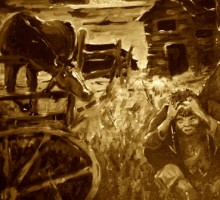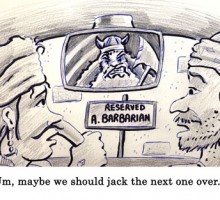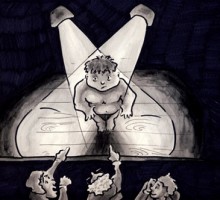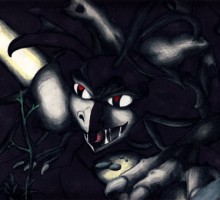My Lovely Wife rides. So I know more than I should about the giant endlessly-plotting creatures called horses. Have I mentioned I don’t ride? 🙂
But I know one thing. Unless you have more money than JK Rowling, and are willing to spend it on a fat sugar-cube-crazy lump called ‘Princess’, you won’t see too many professional riders on out-of-shape ponies. Why not? Cause they want to win. They have to win to get paid. And the best rider in the world isn’t going to get Princess over that ribbon-fluttering* red-and-white-striped 6-foot-high jump.
The same is true in writing. You can be the best writer in the world, and if you want to write a plot about a boy who gets rained in on a weekend and watches an Elmo marathon while his Mom bakes cookies—well, that’s no bestseller, my friend**. No goal, no plot, no stakes. Nope, nope, nope.
Interestingly, in my experience, writing a good premise is also a skill, and tied to your instinctive understanding of plot. I read a bunch of plot books and did a lot of writing, and found that my pitch paragraphs—essentially the book’s premise—got better soon after, almost instinctively. I started answering some writing blog challenges to throw out interesting pitches and began to get notice for them, almost all at once, as if something had clicked. Kind of like when a baseball or golf swing turns from something stiff and over-thought into a natural flowing action. The latter approach sends the ball a lot further, trust me, although you need some practice and awkward swings to get to that point.
As a result, I don’t actually want to give any kind of formula, although they exist out there. But USUALLY a good pitch or premise will include:
- A big or original idea, or twist on an old idea. This can be in almost any aspect, but something has to feel fresh.
- A character, with some brief description. Who faces a problem. And reasonable motivation why it matters to them.
- A goal and consequence for failure, the more exceptionally dire the better.
- (and credit to Ilona Andrews, author of the incredible Kate Daniels series, for this additional point) Some kind of grounding in setting or time frame. In other words, you need to be able to tease out whether the story is medieval sword and sworcery, contemporary setting urban fantasy, or spaceship riding science fiction.
- All of the above should be meshed up in one or two well written paragraphs.
I hesitate to do this, but I’m going to show you the pitch paragraph for my most recent WIP (I also posted this on Ilona’s blog, in a reasonably similar format, and received a pretty positive reception from her and her readers):
In a sprawling and drought-scarred Empire, a paranoid Emperor hunts enemies real and imagined, sending metal-twisting assassins through the night sky. Sixteen-year-old Julian Black and his icy and brilliant brother Devlin have vowed revenge for the death of their mother. First, though, they must win entry into the Broken Mountain, training ground of assassins and Stone Soldiers, to steal the secrets of the Four Facets of magic. No man might know more than one, on pain of horrible death. But the brothers will risk just that to bring the Emperor down.
Separated from his brother, surrounded by danger, Julian finds himself torn between the scarred and beautiful Silvenna, assassin-in-training, and his brother—who may not have told Julian entirely everything about the plan.
It’s a bit longer than a paragraph, but I think that what matters most is overall impact, not any rule on length or structure. It has to be well-written.
I will dwell on this point more later as well, but I’d also suggest reading it aloud in an empty room, normal volume, to see if it flows. This will also help you catch typos, even when your eyes have glazed over from over-editing.
But back to the starting point, how do you know if you’ve got a premise with punch? The answer? Ask people. Almost anybody, they just need to be readers, not writers. I asked my critique group. But instead of just asking for insight on one pitch, I sent them a bunch (seven or eight if I remember), and asked them which ones they liked. My wonderful writing partners liked some, not others, but interestingly both agreed on only one: Black Diamonds.
It was a one hour investment, gathering random ideas, brainstorming pitches, and sending a quick email. And why did I do it?
Because the novel before this, I didn’t, and universally I lost agents at the pitch/ query stage. I wrote the novel and then tried to write the pitch, and had absolutely no idea how to put the former in a concise and appealing package to suit the latter. But I sent it out anyway, and got a resounding chorus of crickets and rejections.
Trust me, starting with a good pitch is much much easier.
As an aside, I still like the previous book, and want to revamp the pitch (now that I’ve hit a better place in that skill set, as mentioned above) and re-work the plot (I leveled up there too). That novel will likely be self-published, given its previous agent experience, but that could be a fun exercise for me as well. If I can think of a good pitch, I might add it in this post, or another one. See what the readers think. 🙂
Because it might save me a boat load of work, to know if the pitch isn’t working first. That vastly increases your chances of commercial success.
Because when you’re coming to that ribbon-covered fence, you’re better off riding a muscle-bound fire-breather named Thor than a sweet little ankle-rubber named Princess. J. K. Rowling or not. 🙂
So best of luck with your pitches! Let me know how they go.
_____________
* Why do I mention fluttering ribbons? For the uninitiated, horses hate fluttery things. It’s because they’re prey animals and think that random things will jump out and eat them. Or so they’ll have you believe. I personally think they just like to buck people off, and laugh about it in the stables after…
** I fully realize that I’m challenging every writer that reads this post to try and prove me wrong, the way I’ve set out a concrete example of a bad plot premise. I read somewhere that Jim Butcher wrote a book after a similar challenge in a writing panel (not the Dresden Files, fyi). Urban myth? Who knows. In any event, if you do take up my challenge, feel free to send me your completed manuscript when done (minimum 60,000 words, don’t waste my time otherwise!) and I’ll acknowledge you in a footnote to the post. I also reserve the right to make incredible fun of you for doing it, but you know, you win some, you lose some. 🙂
The image for this post is an old one as well, and appropriate only for the fact that it had a horse in it. But it had a horse in it, so we were off to the races. (no pun intended). 🙂




